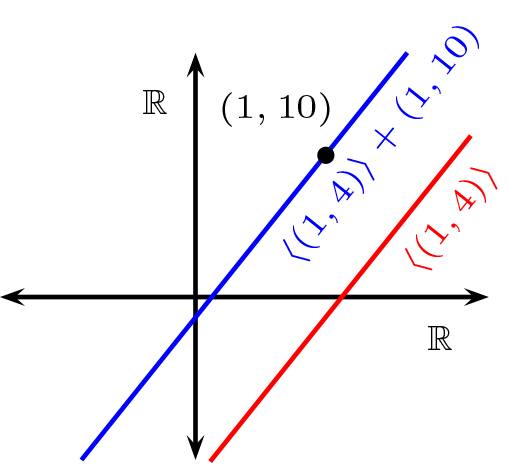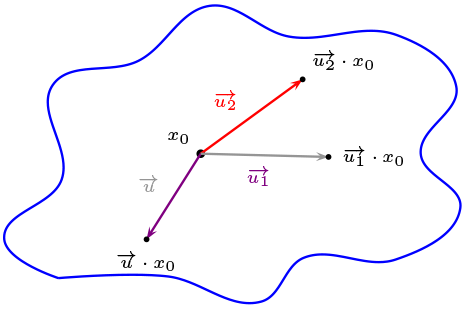Definición 4.3.1
Sea \((V,X, \cdot)\) un espacio afín y \(\mathcal{U}\leq V\text{.}\) Se define
en donde \(S(x_{0},\mathcal{U})\) se denomina subespacio afín, donde \(\mathcal{U}\) es la dirección del subespacio afín.
Para todo espacio afín, se define la nocíon de subespacio afín.
Sea \((V,X, \cdot)\) un espacio afín y \(\mathcal{U}\leq V\text{.}\) Se define
en donde \(S(x_{0},\mathcal{U})\) se denomina subespacio afín, donde \(\mathcal{U}\) es la dirección del subespacio afín.
Sea \(V=X=\mathbb{R}^2\text{,}\) el Espacio Afín vectorial, luego
es un subespacio afín, con dirección \(\left\langle (1,4)\right\rangle\)

Se dice que \(S(x_{0},\mathcal{U})\) es una recta afín si y sólo si \(\text{dim } \mathcal{U}=1\)
Se dice que \(S(x_{0},\mathcal{U})\) es un plano afín si y sólo si \(\text{dim }\mathcal{U}=2\)
Se dice que \(S(x_{0},\mathcal{U})\) es un hiperplano afín si y sólo si \(\text{dim }\mathcal{U}=\text{dim }V-1\)
Sea \((V,X, \cdot)\) un espacio afín y para todo \(x_0\in X\) entonces
Sea \((V,X, \cdot)\) un espacio afín, y \(x\in X.\)
Es una función, ya que \(\overrightarrow{v} \cdot x\) es único. Además \(t_x(\overrightarrow{v})= t_x(\overrightarrow{w})\text{,}\) significa que \(\overrightarrow{v}\cdot x= \overrightarrow{w}\cdot x\text{,}\) pero es único, luego \(\overrightarrow{v}=\overrightarrow{w}\text{.}\)
Por último, dado \(y \in X\text{,}\) existe \(\overrightarrow{xy}\in V \) tal que \(t_x(\overrightarrow{xy})=y\text{.}\)
Por ello tenemos que
En \(V=X=\mathbb{R}^4\) espacio afín evctorial. Sea \(\pi:2x+3y-4z+w=6\text{.}\)
Exprese \(\pi\) en términos de un subespacios afín.
Sea \((x,y,z,w)\in \pi\text{,}\) luego tenemos \(w=6-2x-3y+4z\text{,}\) reemplazando obtenemos,
Denotemos
Luego
Sean \((V,X,\cdot)\) un espacio afín y \(S(x_{0},\mathcal{U})\) un subespacio afín, entonces
Sean \((V,X,\cdot)\) un espacio afín y \(S(x_{0},\mathcal{U})\) un subespacio afín

Veamos primero \(\mathcal{U}\subseteq \left\{ \ \overrightarrow{xy} \ | \ x,y \in S(x_{0},\mathcal{U})\ \right\}\text{.}\)
Sea \(\overrightarrow{u}\in \mathcal{U}\text{,}\) luego \(\overrightarrow{u}\cdot x_0, \ x_0 \in S(x_0,\mathcal{U})\) ya que \(\overrightarrow{u}\) y \(\overrightarrow{x_0 \left( \overrightarrow{u}\cdot x_0 \right) }\) envían \(x_0\) en \(\overrightarrow{u} \cdot {x_0}\) y la unicidad del vector tenemos
de este modo se tiene
Para la otra contención \(\left\{\ \overrightarrow{xy} \ | \ x,y \in S(x_{0},\mathcal{U})\ \right\}\subseteq \mathcal{U}\text{.}\)
Sean \(x,y \in S(x_0,\mathcal{U})\text{,}\) por demostrar \(\overrightarrow{xy} \in \mathcal{U}\text{.}\)
Como \(x,y \in S(x_0,\mathcal{U})\) se tiene que, existen \(\overrightarrow{u_1},\overrightarrow{u_2} \in \mathcal{U}\) tal que
Sea
Por unicidad
con \(\overrightarrow{u_2}-\overrightarrow{u_1} \in \mathcal{U}\text{,}\) luego \(\overrightarrow{w} \in \mathcal{U}\text{.}\)
Sean \((V,X, \cdot)\) un espacio afín, \(x,z \in X\) y \(\mathcal{U} \) subespacios de \(V\text{,}\) entonces
Si \(z \in S(x,\mathcal{U})\) entones \(S(x, \mathcal{U})= S(z, \mathcal{U})\text{.}\)
Si \(S(x, \mathcal{U})= S(z, \mathcal{U})\) entones \(\overrightarrow{xz} \in \mathcal{U}\text{.}\)
Sean \((V,X, \cdot)\) un espacio afín, \(x,z \in X,\ \mathcal{U} \leq V\text{,}\) y \(z \in S(x,\mathcal{U})\) luego tenemos que \(z= \overrightarrow{u}\cdot x\) , con \(\overrightarrow{u}\in \mathcal{U}\)
Ahora bien, notemos que
por ello \(S(z, \mathcal{U})\subseteq S(x, U\mathcal{})\text{.}\)
análogamente, obtenemos que
y con ello la otra contención.
De \(S(x, \mathcal{U})= S(z, \mathcal{U})\text{,}\) tenemos que \(x\in S(z, \mathcal{U})\text{,}\) luego existe \(\overrightarrow{u}\in \mathcal{U}\) que cumple con
es decir, \(\overrightarrow{xz}=\overrightarrow{u}\in \mathcal{U}\text{.}\)
Sean \((V,X, \cdot)\) un espacio afín, \(x,w \in X\) y \(\mathcal{U},\mathcal{W}\) subespacios de \(V\text{,}\) tales que \(S(x,\mathcal{U}) \cap S(w,\mathcal{W})\neq \varnothing\text{,}\) entonces, existe \(z \in X\text{,}\) de modo que
Sea \(z \in S(x,\mathcal{U}) \cap S(w,\mathcal{W})\) , luego por la propiedad anterior tenemos que
Ahora demostraremos que
Para ello, sea \(u \in S(z,\mathcal{U})\cap S(z,\mathcal{W})\text{,}\) luego tenemos por teorema anterior
de lo cual tenemos \(\overrightarrow{uz} \in \mathcal{U}\cap \mathcal{W}\text{,}\) de este modo \(u \in S(z,\mathcal{U}\cap\mathcal{W})\text{.}\)
Para la otra contención, sea \(u \in S(z,\mathcal{U}\cap \mathcal{W})\text{,}\) luego tenemos por teorema anterior \(\overrightarrow{uz} \in \mathcal{U}\cap \mathcal{W}, \) de lo cual tenemos \(\overrightarrow{uz} \in \mathcal{U} \wedge \overrightarrow{uz}\in \mathcal{W}\text{,}\) de este modo \(u \in S(z,\mathcal{U}) \cap S(z,\mathcal{W})\text{.}\)
Sean \((V,X, \cdot)\) un espacio afín, \(x_i \in X\) y \(\mathcal{U}_i\) subespacios de \(V\text{,}\)para todo \(i\in I\) tales que \(\cap_{i\in I} S(x_i,\mathcal{U}_{i}) \neq \varnothing\text{,}\) entonces, existe \(z \in X\text{,}\) de modo que
Sean \((V,X, \cdot)\) un espacio afín, \(x,w \in X\) y \(\mathcal{U},\mathcal{W}\) subespacios de \(V\text{,}\) entonces \(S(x,\mathcal{U})=S(w,\mathcal{W})\) si y sólo si \(\mathcal{U}=\mathcal{W}\ \wedge \ S(x,\mathcal{U}) \cap S(w,\mathcal{W})\neq \varnothing\)
Supongamos que \(\mathcal{U}=\mathcal{W}\) y \(S(x,\mathcal{U})\cap S(w,\mathcal{W})\neq \varnothing\text{,}\) por demostrar que \(S(x,\mathcal{U})=S(w,\mathcal{W})\text{.}\)
Sea \(z \in S(x,\mathcal{U})\cap S(w,\mathcal{U})\text{,}\)
Ahora supongamos que \(S(x,\mathcal{U})=S(w,\mathcal{W})\text{,}\) por demostrar \(\ \mathcal{U}=\mathcal{W} \) y \(S(x,\mathcal{U})\cap S(w,\mathcal{W})\neq \varnothing\)
Por teorema anterior
Además \(S(x, \mathcal{U})=S(w,\mathcal{W})\text{,}\) se tiene entonces que \(S(x,\mathcal{U}) \cap S(w,\mathcal{W}) \neq \varnothing\text{.}\)
Grupo de las Traslaciones.
Sea \((V,X,\cdot)\) un espacio afín y \(\overrightarrow{u} \in V\)
Se dice que \(t_{\overrightarrow{u}}\) es una traslación en la dirección del vector \(\overrightarrow{u}\text{,}\) en el conjunto \(X\text{.}\)
\(t_{\overrightarrow{u}}\) es una función biyectiva.
\(t_{\overrightarrow{u}}\) es inyectiva, sean \(x, y \in X\) por demostrar \(t_{\overrightarrow{u}}(x)=t_{\overrightarrow{u}}(y)\text{,}\) entonces \(x=y\)
Para ello veamos
De este modo \(t_{\overrightarrow{u}}\text{ es inyectiva}\text{.}\)
\(t_{\overrightarrow{u}}\) es epiyectiva, por demostrar que \(\text{Rec } (t_{\overrightarrow{u}})=X\)
La primera contención es evidente que \(\text{Rec } (t_{\overrightarrow{u}})\subseteq X\text{,}\) basta demostrar que \(\text{Rec } (t_{\overrightarrow{u}})\supseteq X\text{.}\)
Dado \(x \in X\)
Luego \(t_{\overrightarrow{u}}\) es epiyectiva, de este modo \(t_{\overrightarrow{u}}\) es biyectiva.
Sea \((V,X,\cdot)\) un espacio afín, entonces
\(\mathcal{T}(X)\) es un grupo, llamado el grupo de las traslaciones del espacio afín.
Consideremos las aplicación, que además cumple con:
Además por unicidad tenemos \(t_{\overrightarrow{u}}(x)=t_{\overrightarrow{v}}(x)\) se tiene que \(\overrightarrow{u}= \overrightarrow{v}\text{.}\)
Sean \((V,X,\cdot)\) un espacio afín, \(\overrightarrow{u},\overrightarrow{v}\in V\) y \(x_0\in X\) entonces
es decir, \(t_{\overrightarrow{v}}\) respeta paralelismo de la rectas.
Sean \(\overrightarrow{u},\overrightarrow{v}\in V\) y \(x_0\in X\)
Sean \((V,X,\cdot)\) un espacio afín, \(\overrightarrow{v}\in V\text{,}\) \(\mathcal{U} \leq V\) y \(x_0\in X\) entonces